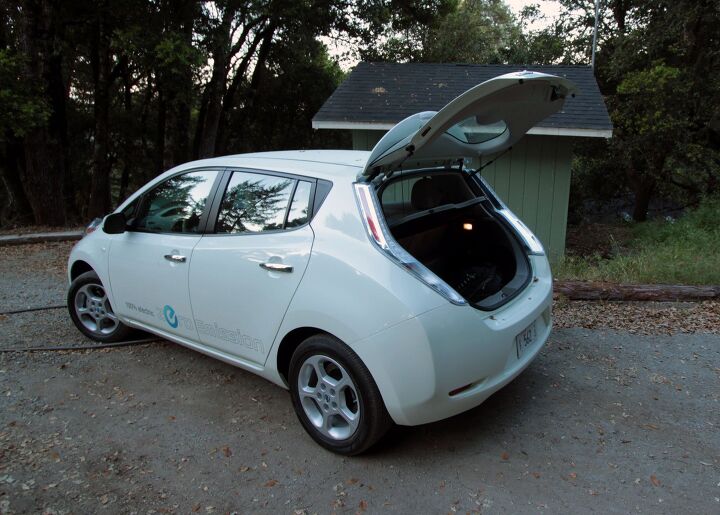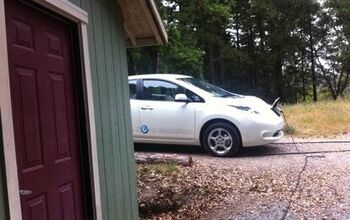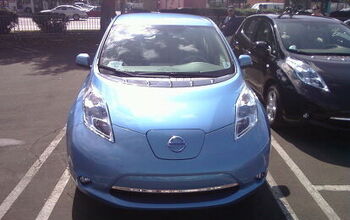Review: 2011 Nissan Leaf: Day Three

The previous day’s usage had left me in a pickle. With the 12 miles left and only nine-and-a-half hours charging time at 120V. Of course if I constantly had to remind myself, if I had a 240V charging station at home this would be a non-issue as the Leaf would have been completely full. However, my situation as it was, the Leaf was perhaps a hair over 40% charged when I left for work with the range indicator displaying 59 miles, hopefully enough for my 57 mile drive.
Since I needed all the juice I could get to make it to Burlingame I decided to forgo the pre-heating and let the Leaf charge to the very last second. Fortunately this morning was a hair warmer than the day previous being a brisk 40 degrees. Unfortunately the temperatures and humidity conspired to fog the windscreen. Without sufficient power to make it to work and use the defogger, I chose to defog the old-fashioned way: windows open.
Thankfully the climb up to the summit of the Santa Cruz Mountains was gradual in comparison to the re-charging trip down the other side. Once back on flat land the car indicated a range of 52 miles and I only had 40 miles ahead of me. Right as I was patting myself on the back, US-101 ground to a total and complete halt. We’ve all been there before right? You forget your purse or wallet, your car is running on fumes and that is the exact moment when you encounter heavy traffic. Much like a hybrid however, if you drive the car gently in the stop-and-go traffic the battery usage turns out to be relatively low. Of course if you are buying your leaf in California or a few other states, you would qualify for carpool access stickers making waiting in traffic a much rarer event. Since my car was not so equipped, I inched along the bay for 45 minutes traveling a whopping 5 miles in that time. Once traffic started flowing freely the car announced I may not have enough power to reach my destination. True to form, three miles before my exit the range indicator went from “3 miles” to “- – – ,“ indicating a depleted battery.
Trip distance: 57.1
Average speed: 32.4 mph
Travel Time: 1:45bad traffic
Average miles/kWh: 6.8
Range Left: 0
Temp: 40-48 degrees
Since Nissan needed to pick the Leaf up, I ponce again connected my trans-sidewalk charging cable and checked the display for a charge time: 31 hours to full. Ouch. I find I need to keep reminding myself that had I access to a 240V charging station at home, the battery would be more than half full on my arrival. Since the press fleet doesn’t come with some funky dryer-plug hacked charger (sort of a shame really) the emergency trickle charge cable was our only option. And there is the problem I see with some of the TV news bites I have seen about the Leaf; which I am sure will be re-ignited once the rumored Top Gear episode featuring the Leaf hit the airwaves: The 31 hour charge time is not likely to be an issue for buyers as most people seem to buy the home charging station.
Currently the Leaf is only available as a hatch back in two trim lines SL and SV. In reality there is little difference between the two trims as both receive 16-inch alloy wheels, LED headlamps keyless entry and keyless go, power windows, cruise control, Bluetooth, navigation system with CD player, six speakers and iPod/USB integration. The SL model adds a spoiler solar panel (yes it seems as useless ad it sounds), automatic headlamps, fog lamps, a rearview camera, a cargo cover and the option to purchase the $700 CHAdeMO DC quick-charge port. Our SL tester was a pre-production model so it did not itemize the CHAdeMO port on the Monroney sticker; as a result the price as tested was $33,720 before rebates. As I live in California, after the $7,500 federal and $5,000 state rebates, the Leaf drops to a commuter car appropriate sticker of $21,220.
As I indicated before, weight constraints are largely due to the lack of window shattering stereo performance. Still, the system is adequate for most listeners. USB/iPod integration is about average for the segment allowing full control of your Apple device and playlist/artist/album browsing while on the road. Sadly like most Japanese vehicles sold on our shores, the Nav system is not operable when in motion and like other Nissan products this means you have to completely stop in order to enter a destination as the voice commands do not extend to destination entry. This is something of an odd choice for Nissan to make since you can easily spend far more time distracted by searching for that ZZ Top album than entering the address of that charging station you are looking for.
Compared to the Chevy Volt, the Leaf is $12,000 cheaper (after rebates) and qualifies for carpool lane usage over here on the left coast. Arguably the Volt is a car without the sort of lifestyle compromises that must be made if you used tour Leaf as a daily driver, but on the other hand, you could buy a Nissan Versa with that $12,000 and have two cars for the price of one Volt. Until the Ford Focus Electric surfaces later this year, the Leaf has little competition. [Correction: due to an amended Senate Bill in California the Volt and other plug-in hybrids will be allowed HOV lane access. Thanks to our readers that pointed this out. ]
How green is the Leaf? That depends on how you look at it. Although in terms of volume the US is the world’s largest producer of electricity from geothermal, solar and wind resources, these only account for 11 percent of the total electric production in the US (US Energy Information Administration 2010). As energy demand continues to rise in America the percentage of our power that comes from renewable resources has actually dropped rather than increased since the 1960s. Since 70% of all the electricity produced in the US contributes to global warming, you might almost say that any electric car driven in this country is half-powered by coal. Unless you’ve invested in solar panels, driving a Leaf could be said to be burning coal in a square state to feel green in California. I am told that despite the decidedly un-green power mixture in the USA, total greenhouse emissions from the Leaf (when you consider the power generation) are still lower than just about any car on the road today.
After three days of self-induced anxiety it was time for Nissan to collect the Leaf. As the battery powered commuter car was driven away slowly and replaced by its antithesis (a Mercedes CL550) I was forced to reflect on the previous 62 hours. Bottom line, the Leaf is a commuter car. This term has never been so appropriately applied to a single model before. While some may buy a Prius or Fiesta to commute, they are still multi-purpose vehicles while the Leaf has a more singular focus. Just like you would not expect a 2-door sports coupé to be all things to everyone, neither can we expect a short range full electric vehicle to be everyone’s cup of tea.
ABC News Polls indicated in 2005 that the average American’s commute is 16 miles. Let’s say we don’t believe that and use 30 miles as a number. In a hot climate like Arizona, a Leaf would essentially make it to and from work without issue even when driving it like a normal car. That in itself is the function. It’s not made for long commutes (although with an 8 hour day and 240V charging at each end, even an 80 mile commute would be possible.) If you can set your anxiety aside, have a 240V home charger or live near a planned 480V quick charge station and are looking for a commuter car, the Leaf makes more sense than any number of $21K cars especially when you consider the California carpool sticker. Before you jump on the Leaf pile, check with your tax guy as there may be some tax liabilities in regards to the rebates.
Nissan provided the vehicle and insurance for this review.
Checkout the other instalments of our Leaf trilogy:

More by Alex L. Dykes
Latest Car Reviews
Read moreLatest Product Reviews
Read moreRecent Comments
- MaintenanceCosts I wish more vehicles in our market would be at or under 70" wide. Narrowness makes everything easier in the city.
- El scotto They should be supping with a very, very long spoon.
- El scotto [list=1][*]Please make an EV that's not butt-ugly. Not Jaguar gorgeous but Buick handsome will do.[/*][*] For all the golf cart dudes: A Tesla S in Plaid mode will be the fastest ride you'll ever take.[/*][*]We have actual EV owners posting on here. Just calmly stated facts and real world experience. This always seems to bring out those who would argue math.[/*][/list=1]For some people an EV will never do, too far out in the country, taking trips where an EV will need recharged, etc. If you own a home and can charge overnight an EV makes perfect sense. You're refueling while you're sleeping.My condo association is allowing owners to install chargers. You have to pay all of the owners of the parking spaces the new electric service will cross. Suggested fee is 100$ and the one getting a charger pays all the legal and filing fees. I held out for a bottle of 30 year old single malt.Perhaps high end apartments will feature reserved parking spaces with chargers in the future. Until then non home owners are relying on public charge and one of my neighbors is in IT and he charges at work. It's call a perk.I don't see company owned delivery vehicles that are EV's. The USPS and the smiley boxes should be the 1st to do this. Nor are any of our mega car dealerships doing this and but of course advertising this fact.I think a great many of the EV haters haven't came to the self-actualization that no one really cares what you drive. I can respect and appreciate what you drive but if I was pushed to answer, no I really don't care what you drive. Before everyone goes into umbrage over my last sentence, I still like cars. Especially yours.I have heated tiles in my bathroom and my kitchen. The two places you're most likely to be barefoot. An EV may fall into to the one less thing to mess with for many people.Macallan for those who were wondering.
- EBFlex The way things look in the next 5-10 years no. There are no breakthroughs in battery technology coming, the charging infrastructure is essentially nonexistent, and the price of entry is still way too high.As soon as an EV can meet the bar set by ICE in range, refueling times, and price it will take off.
- Jalop1991 Way to bury the lead. "Toyota to offer two EVs in the states"!


















































Comments
Join the conversation
Excellent reviews, and comments! I'm on the list for a Leaf, which should be delivered in about 7 months. I live in the San Diego area, and have just installed 30 solar panels on my roof. This will zero-out my electric bill. I may add 10 more panels, to offset the additional electricity consumed by the Leaf 240 volt charger. I will be producing electricity during peak times, and consuming it to charge the Leaf during non-peak times (evening). I think the Leaf will be perfect for my needs. The range is not an issue for me, as I only drive around town, and will remain well within the range limitations. I have another car for longer trips, as necessary, which will be seldom used. The federal and state subsidies are attractive, and will make the purchase more affordable. Expensive? Yes, but over time, the overall fuel and solar electrical savings will eventually be worth it. It will be nice knowing that the sun is essentially fueling my car. My reason for being interested and solar power and the Leaf is principally not having to rely on foreign oil. The environmental concerns are secondary, as I don't really think that anthropogenic climate change science is as solid as many believe. If it turns out to be true, well then, at least I'm doing part. It will be very nice knowing that less of my money will be going overseas to some regimes that don't really like us, and who are killing our soldiers.
I ride my bike mostly and being such a masochist also somehow have anywhere from 3-5 other semi broke-down dino-blood guzzling vehicles to pick from if the need arises. Last year I spent about $400 bucks building an electric bike and wow was that thing more fun than a sack of potatoes. It is a bicycle that freaking pedals itself. Hippie chicks throw the underwear they aren't wearing right at me. Now I can be a lazy masochist for about 15 miles which is plenty time to grab some sushi, fair trade coffee, and swing by liquor store for some locally made tennessee whiskey. Ironically I also bought about 4000lbs of american steel in jeep cherokee chief form for the same price except it doesn't move quite as well. Now I can both save and destroy the world at the same time for about 1/26th the price of a new leaf! This is a great review for those that buy new cars and I can eagerly await the fallout when these hit the used market. EV's are a different mindset but in my opinion a happier more carefree one. With my motorcycle I am worried about which random engine component will attempt to shoot itself through the block and into my crotch next but with the electric all that we worry about is 'if it has enough juice to get home'. My biggest thought is when these things (electric leafs) get to be the broken, abused, neglected and downright much more affordable used car that people like me can afford... who is going to take care of them? Will they be worth anything if a new battery pack is 5 grand? Could I swap in a 454 and a powerglide with that same 5 grand? My loins quiver with anticipation of the hybrid v8+ 4 barrel swaps we shall soon see. Only time will tell.